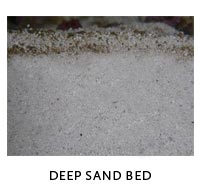Deep Sand Bed
A home aquarium is too small to fully replicate the conditions and processes of marine habitats, but the more closely it does so, the better for its inhabitants. Including some of the processes in the nutrient cycle should also mean less work for you, and deep sand beds can help.
Deep Sand Bed Purpose
Ideally, a deep sand bed eliminates the need for mechanical filtration and cleaning, effortlessly dealing with the potentially dangerous waste products your fish, invertebrates and algae produce. In practice, deep sand beds normally reduce the need for filtration and maintenance, but tank conditions need monitoring and additional methods are often required.
How it Works
 Deep sand beds act as a form of biological filtration, with the idea being that nutrients sink into the substrate, where they are processed by microorganisms, aerobic bacteria and other organisms at the top and anaerobic bacteria lower down.
The events in the top layer must happen anyway in an aquarium – establishing a community of such microbes is the whole purpose of cycling.
However, a thick layer of sand helps in the confines of a tank because it gives the microorganism community more time and space to get the job done.
A sand bed may also provide a home for somewhat larger detritivores, such as flatworms.
Deep sand beds act as a form of biological filtration, with the idea being that nutrients sink into the substrate, where they are processed by microorganisms, aerobic bacteria and other organisms at the top and anaerobic bacteria lower down.
The events in the top layer must happen anyway in an aquarium – establishing a community of such microbes is the whole purpose of cycling.
However, a thick layer of sand helps in the confines of a tank because it gives the microorganism community more time and space to get the job done.
A sand bed may also provide a home for somewhat larger detritivores, such as flatworms.
Deep Sand Bed Creation
You need, obviously, sand, but choose the right sort. Very coarse, almost gravelly sands might be aesthetically pleasing but they don't form a good habitat for most of the micro and macroorganisms in question. A sand consisting of a variety of grain sizes, predominately fine ones, does the job far better. The setting up process is far from complex. hen preparing the tank, just add several inches of sand at the bottom, the deeper the better. Add live sand, which should contain a good starter population of organisms, to get it started and cycle the tank as normal.
Precautions
In comparison to most natural habitats, an aquarium is densely populated, with its denizens producing a great deal of waste relative to the space. A deep sand bed might not be sufficient to keep things in balance. Conduct regular tests and have additional filtration methods ready to install if required. If the sand bed is not deep enough, it might not work very well and, more importantly, toxins produced in the bottom layer could enter the water. Aim for a depth of at least four inches, preferably six or more. It probably goes without saying that burrowing or sifting creatures and deep sand beds don't mix.